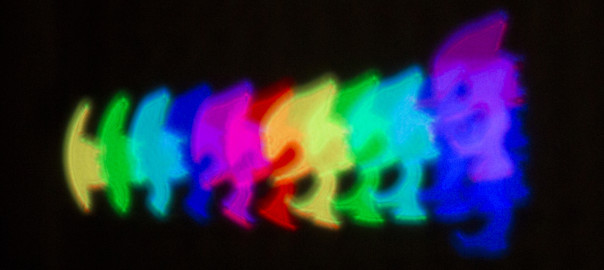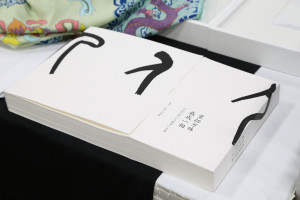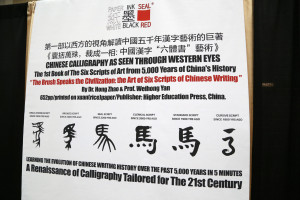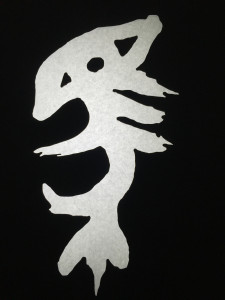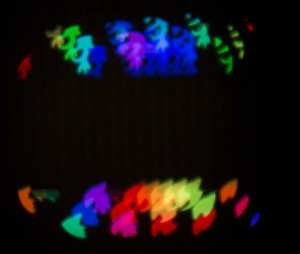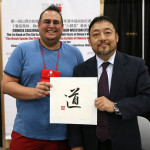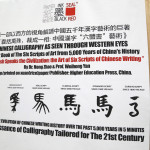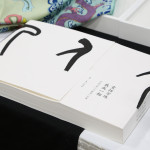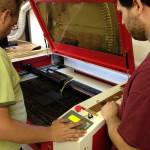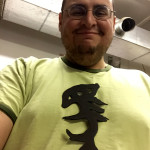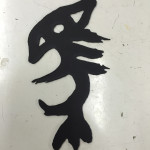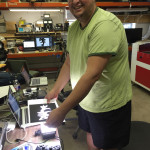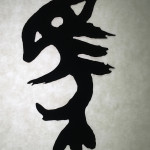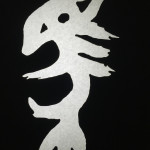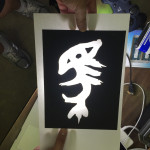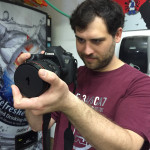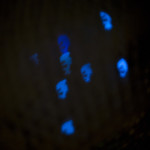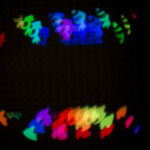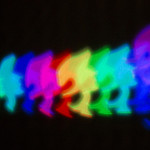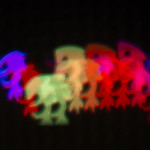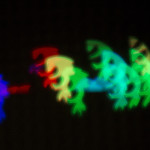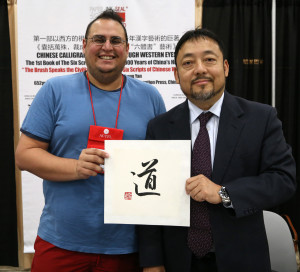 Over the past year convergent media member professor joey lopez (Editors NOTE: professor joey lopez requests that his name be lowercase in an effort to create reflexive awareness of power structures) has been working on a special project to develop convergent media representations of Chinese Calligraphy through various mediums and convergent media technologies. His interest began when he was approached by Professor Weihong Yan, Executive Director of the Confucius Institute and Associate Professor of Chinese/Language/Culture/Business at Pfeiffer University in Charlotte, North Carolina, when he visited San Antonio for The American Council on Teaching Foreign Languages Conference. Angelica Docog, the director of the University of Texas San Antonio Institute of Texan Cultures introduced professor joey lopez and Professor Weihong Yan after seeing they have similar interests in story telling with high-end media. Professor Weihong Yan told professor joey lopez of a book he had recently finished about Chinese Calligraphy called The Brush Speaks an Ancient Civilization –The Six Writing Styles of Chinese Calligraphy, which includes over 12,000 years of Chinese Calligraphy. The work impressed professor joey lopez through it’s high-end execution and intellectual foresight. Professor joey lopez saw the rich history, the contextualization and significance of work right away and was highly intrigued and began thinking about possible ways to collaborate.
Over the past year convergent media member professor joey lopez (Editors NOTE: professor joey lopez requests that his name be lowercase in an effort to create reflexive awareness of power structures) has been working on a special project to develop convergent media representations of Chinese Calligraphy through various mediums and convergent media technologies. His interest began when he was approached by Professor Weihong Yan, Executive Director of the Confucius Institute and Associate Professor of Chinese/Language/Culture/Business at Pfeiffer University in Charlotte, North Carolina, when he visited San Antonio for The American Council on Teaching Foreign Languages Conference. Angelica Docog, the director of the University of Texas San Antonio Institute of Texan Cultures introduced professor joey lopez and Professor Weihong Yan after seeing they have similar interests in story telling with high-end media. Professor Weihong Yan told professor joey lopez of a book he had recently finished about Chinese Calligraphy called The Brush Speaks an Ancient Civilization –The Six Writing Styles of Chinese Calligraphy, which includes over 12,000 years of Chinese Calligraphy. The work impressed professor joey lopez through it’s high-end execution and intellectual foresight. Professor joey lopez saw the rich history, the contextualization and significance of work right away and was highly intrigued and began thinking about possible ways to collaborate.
As a founding member of the Convergent Media Collective, professor joey lopez’s places an importance of cross pollination of social and cultural capital across geographical space. Professor Weihong Yan asked professor joey lopez if he would be able to prototype out other cultural representations of the Chinese Calligraphy using convergent media techniques.
This opportunity was a mutually welcomed collaboration due to both professor joey lopez and Professor Weihong Yan’s desire to share culture across geographical spaces. Professor joey lopez’s vision is to create prototypes that he can then share with Professor Weihong Yan in an effort to create a set museum quality pieces that can be shared with the public at large to bring awareness of the rich heritage Chinese culture contains within not only it’s history, but literally in the way it was written.
The following prototypes and demos are the initial results of joey’s initiative to build convergent media representations of the Chinese Calligraphy he was exposed to. In addition to being convergent media, they were also created in a way to take on new cultural meaning and social significance in an effort to diversify their interpretation as symbols. Professor joey lopez’s main collaborator in the development of these concepts and prototypes is Jeremy Zunker, an electrical engineer, software programmer and maker.
Back Lit Laser Cut Chinese Calligraphy Concept and Prototype
Concept- This concept grew out of a discussion joey had with Angelica about his desire to prototype some laser cut representations of the Chinese Calligraphy. Suddenly he saw it in his head and presented the concept. A laser cut representation, two prototypes. One using the laser cut piece and the other using the inverted cut piece. The concept is to back light them using various light sources to draw the patrons eye towards the shape of the pieces. The light representing knowledge, the Chinese Calligraphy representing the interpretation and place keeper of the knowledge.
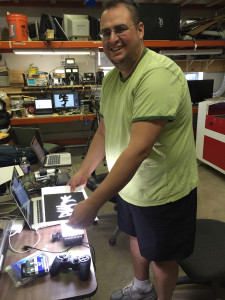 Prototype- In order to create this prototype, joey used an image of the Chinese Calligraphy Bronze Age character for the Horse provided by Weihong Yan. He imported the image into Adobe Photoshop and created a solid interpretation of the hand painted character. He then imported it into Adobe Illustrator and then vectorized the image, taking it from a pixel based image to a mathematically vector based representation. This processing then allowed for the image to be imported into AutoCAD, where the vector file was edited further and prepped to be imported into the laser cutter software. The image was then imported into the laser cutter software where it was then scaled to fit the material being used. The laser cutter itself is a Chinese manufactured HX-1290SE model with 80 Watts of power. It has the ability to cut various kinds of material. For this prototype I had wanted to use acrylic, but decided to wait and use a heavy stock black cardboard, which I believe worked out well.
Prototype- In order to create this prototype, joey used an image of the Chinese Calligraphy Bronze Age character for the Horse provided by Weihong Yan. He imported the image into Adobe Photoshop and created a solid interpretation of the hand painted character. He then imported it into Adobe Illustrator and then vectorized the image, taking it from a pixel based image to a mathematically vector based representation. This processing then allowed for the image to be imported into AutoCAD, where the vector file was edited further and prepped to be imported into the laser cutter software. The image was then imported into the laser cutter software where it was then scaled to fit the material being used. The laser cutter itself is a Chinese manufactured HX-1290SE model with 80 Watts of power. It has the ability to cut various kinds of material. For this prototype I had wanted to use acrylic, but decided to wait and use a heavy stock black cardboard, which I believe worked out well.
The laser cutting process took a minute or so and afterwards we had both a nicely cut character and the pieces to put an inverted character together.
After having the pieces cut we found some paper and used an LED light panel I had on hand to create some prototype images of the Chinese Calligraphy Bronze Age Horse character being illuminated from behind with a medium stock piece of paper between it and the light. The result was a amazing. Our next step will be to further refine this prototype into a museum grade installation piece that has an “aura” to it that inspires the patron to feel confident when viewing it.
Laser Cut Chinese Calligraphy Bokeh Lens Cover Concept and Prototype
Concept- This concept came from Jeremy Zunker after laser cutting the initial Chinese Calligraphy Bronze Age Horse. Having read online about the ability to create bokeh filters with laser cut materials. Bokeh is the blur created by using low aperture settings. The side effect of the Bokeh is that whatever is not in focus that is a light source often takes on the shape of the lens aperture being used. So the concept of the Chinese Calligraphy Bokeh Lens Cover was to create a cover that when the out of focus light sources created a custom Bokeh effect.
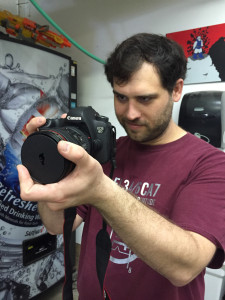 Prototype- The prototype was created by Jeremy Zunker. He took a set of digital calipers and measured how many millimeters the Canon 6D’s 24-105 L Series len’s inner diameter and then in the laser cutting software placed the Chinese Calligraphy Bronze Age Horse in the circle. The initial prototype proved to be too large of a character to create the desired amount of Bokeh effect. Jeremy then made the Chinese Calligraphy Bronze Age Horse character smaller and it worked perfectly. As you can see in the images and videos provided, the out of focus LED’s we took photos and video of have a distinct representation of the character we laser cut.
Prototype- The prototype was created by Jeremy Zunker. He took a set of digital calipers and measured how many millimeters the Canon 6D’s 24-105 L Series len’s inner diameter and then in the laser cutting software placed the Chinese Calligraphy Bronze Age Horse in the circle. The initial prototype proved to be too large of a character to create the desired amount of Bokeh effect. Jeremy then made the Chinese Calligraphy Bronze Age Horse character smaller and it worked perfectly. As you can see in the images and videos provided, the out of focus LED’s we took photos and video of have a distinct representation of the character we laser cut.
While seemingly novel, this prototype has an array of possibilities both in terms of literal meaning, but more so when combined with other techniques, such as abstract and narrative story telling where the Bokeh can then be used to add extra meaning emphasis to the works created.
Mixed Media Projection Mapped Chinese Calligraphy
Concept- The concept is to develop a processing of the Chinese Calligraphy Characters through projection mapping software such as MadMapper and Modul8 to create unique immersive environments that exposes the richness of the Chinese Calligraphy.
Light Painting Chinese Calligraphy Concept
Concept- Light painting is the use of long exposure photography along with a light source as a “paint brush”. The concept of light painting Chinese Calligraphy is to bring the art to a medium which is visually engaging when show at a large scale.
Cultural Re-interpretation Concept
Concept- Professor joey lopez is a anthropologist at heart and his interest in how cultural practices and re-appropriation of Chinese Calligraphy can be interpreted by hybrid cultures. The concept for cultural re-interpretation of Chinese Calligraphy is to take some of the characters and juxopose and are immerse them in western mass media. A simple example may be using the Chinese Calligraphy Bronze era Horse into a major western car manufacture’s symbol. Such a practice would create an assimilation and introduction to western pop culture of Chinese Calligraphy characters.
